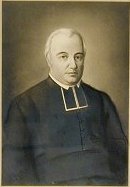Foundation

Esther Blondin (1809-1890) was the daughter of simple farmers in the village of Terrebonne, Quebec. Through her work as a domestic servant to the teaching Sisters of the Congregation of Notre Dame of Montreal who had opened a parochial school in the town, she came to learn how to read and write. She was accepted to the novitiate of the Sisters in 1833, but soon had to leave for reasons of health. Later that same year, having recovered her health, Blondin accepted the invitation from another former novice of the Congregation, who was running a parochial school in Vaudreuil, to join her in teaching there. Within a few years, she had become the principal of the school, then known as the Académie Blondin, where she trained teachers for the rural schools of the province. [2]
Over the years, Blondin found out that one of the causes of the widespread illiteracy in the French-speaking community was a certain Church ruling that forbade that children be taught by members of the opposite sex. Unable to finance two schools, many parish priests chose to have none. In 1848 Esther presented to the Bishop of Montreal, Ignace Bourget, a plan to found a religious congregation "for the education of poor country children, both girls and boys in the same schools." Despite the novelty of the suggestion and possible violation of Church rules, since the Canadian government was in favour of such schools he authorized the experiment. [3] She obtained the commitment of several young women for this endeavor and a novitiate was opened to form members for the proposed new congregation on 13 September 1848. [4]
The first postulants (admission-seeking candidates) of the congregation received the habit of the new Congregation of the Daughters of Saint Anne, as it was originally named, on 15 August 1849. This group included Blondin, who received the religious name of Sister Marie Anne. [5]

Of this group, Blondin and four other Sisters made their profession of religious vows on 8 September 1850, [4] thereby allowing the congregation to become legally formed. One barrier to this, however, was a community debt of about £1,500. This debt was paid by the local pastor, the Abbé Paul-Loup Archambault (1787 – 1859), [6] clearing the way to their establishment under canon law. Blondin was named the superior of the congregation, becoming referred to as Mother Marie Anne. In March 1851 Bourget wrote a Rule of Life and Constitutions for the congregation. By October of that same year, the congregation had grown to such an extant that a new community was established in Sainte-Geneviève. [5]
On 22 August 1853, to accommodate their growing numbers, the Sisters were moved by Bourget from Vaudreuil to Saint-Jacques de l'Achigan. At that time, he appointed the Abbé Louis-Adolphe Maréchal as chaplain to the community. This priest began to exercise a dictatorial control of the community, determining on his own the school fees, and pressuring the Sisters not to exercise their right to go to a confessor of their choice, but solely to him. As a result of this conflict, the bishop instructed Mother Marie Anne to resign as Superior of the community as of 18 August 1854, calling for new elections. He further commanded that she neither offer her name for re-election, nor accept election. Though elected to the General Council twice, she was kept from any further participation in the administration of the congregation. [3]
At the election which was then held, Mother Marie Jeanne de Chantal was elected the superior of the congregation. In 1857 Bourget made some final revisions to the Constitutions, which he then provisionally approved. That year a new habit was adopted by the congregation, and all the Sisters underwent a new investiture. The congregation held its first General Chapter in 1860. The following year, Mother Jeanne de Chantal purchased Simpson Manor in Lachine, which became the General Motherhouse in 1864. The decretum laudis of the Holy See was received in March 1863. Final approval of the Constitutions was granted by Bourget on 13 February 1875. In 1884 final approval of the congregation was granted by Pope Leo XIII. The name of the congregation was changed to its current one on 12 July 12, 1888. [5]
The practice of admitting women to serve the congregation as lay sisters began in 1891. They helped to operate its various institutions until 1926, when the practice was ended. [5]
